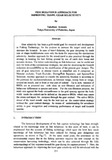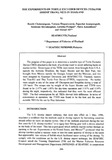Methodology of Evaluating Selectivity Performance - Two Selective Processes of Trawl Sorting Devices: Fish Encountering and Being Sieved
Share
Abstract
The mesh selectivity of each mesh size is a basic study for size-sorting, and usually expresses the proportion retained as a function of the body length of a fish. It is however likely to depend more directly on the relationship between the girth of fish and mesh perimeter whether a fish can pass through a mesh. Selectivity curves sm(G / p) fitted to some experimental data in terms of the ratio of girth G to mesh perimeter p coincided closely for several species of different body shape. This means that geometrically similar combinations of mesh perimeter and girth have the same selectivity, and also suggests that a master curve based on girth to mesh perimeter allow estimation of the selectivity curve with girth-length relationship. The master curve analysis method is useful in particular for multi-species trawl fishery in tropical and sub-tropical areas. From the Nordmore grid fishing experiments, the grid had size-selectivity by barspacing in the similar as well as codend mesh selectivity. As far as grids have size-selectivity as a sieve process, sorting efficiency must depend not only on barspacing but also on length distributions of each species, and therefore the appropriate bar-space should be determined for sorting. The master curve analysis method can be applied to grid selectivity (proportion of fish retained by the grid). Sieving process of sorting device like grid and square mesh window panel is valid only for fishes encountering it. Another point in the sorting efficiency is the encounter probability defined as a proportion of a fish encountering the sorting device.
Suggested Citation
Tokai, T. (1997). Methodology of evaluating selectivity performance - two selective processes of trawl sorting devices: Fish encountering and being sieved. In Proceeding of the Regional Workshop on Responsible Fishing, Bangkok, Thailand, 24-27 June 1997 (pp. 242-250). Samut Prakarn, Thailand: Training Department, Southeast Asian Fisheries Development Center.
Subject
Related items
Showing items related by title, author, creator and subject.
-
Fish Behaviour Approach for Improving Trawl Gear Selectivity
Arimoto, Takafumi (Training Department, Southeast Asian Fisheries Development Center, 1997)Gear selectivity has been a gold-medal goal for research and development in Fishing Technology, for the purpose to increase the target catch and to decrease the bycatch. In case of trawl fisheries, the gear designing by ... -
The Experiments on Turtle Excluder Devices (TEDs) for Shrimp Trawl Nets in Thailand
Chokesanguan, Bundit; Theparoonrat, Yuttana; Ananpongsuk, Supachai; Siriraksophon, Somboon; Podapol, Lertchai; Aosomboon, Peera; Ali, Ahmad (Training Department, Southeast Asian Fisheries Development Center, 1997)The purpose of this paper is to determine a suitable type of Turtle Excluder Device (TED) attached to the body of a shrimp trawl to avoid inflicting harm on marine turtles. Seven types of the TEDs were tested; three brought ... -
Application of the Australian Trawl Efficiency Device in Australia s Northern Prawn Fishery
Mounsey, Richard (Training Department, Southeast Asian Fisheries Development Center, 1997)The following paper is made up of three field trip reports covering the testing and commercial use of the Australia Trawl Efficiency Device (AusTED). The work was carried out in the Northern Prawn Fishery (NPF) aboard five ...





